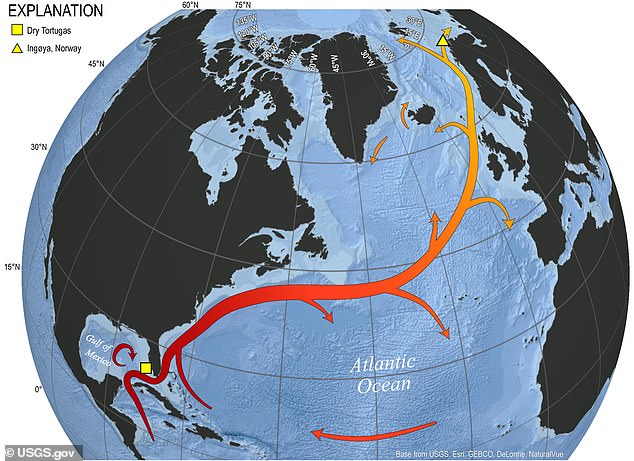Understanding the Gulf Stream and Its Critical Role
The Gulf Stream is a powerful ocean current that transports warm surface water from the Gulf of Mexico, moving it northward across the Atlantic towards Europe. This current plays a vital role in regulating global weather patterns, particularly keeping northern and western Europe relatively temperate. However, recent research suggests that this critical system is weakening at an alarming rate, with potential consequences that could be far-reaching.
According to a new study led by Edward Forman from the University of Southampton and James Baldini from Durham University, the Gulf Stream has been showing signs of decline for much longer than previously believed. The researchers found evidence that the current began to slow down as early as 300 years ago—well before the Industrial Revolution. This discovery indicates that the system may be more sensitive to climate change than previously thought.
The Gulf Stream is part of a larger ocean circulation system known as the Atlantic Meridional Overturning Circulation (AMOC). Often referred to as the ‘conveyor belt of the ocean,’ AMOC moves warm, salty water from the tropics toward the northern hemisphere. As this warm water reaches the North Atlantic, it releases heat into the atmosphere and then freezes. The salt left behind increases the density of the water, causing it to sink and flow back southward in deep ocean currents. Eventually, this water rises again through a process called upwelling, completing the cycle.
This circulation system is crucial for maintaining the climate balance in regions such as Europe, the UK, and the eastern coast of the United States. If the AMOC weakens significantly, it could lead to dramatic changes in regional weather patterns. Northern Europe, for instance, could experience extreme cooling of up to 15°C, which would override the warming effects caused by human activity. Meanwhile, rainfall and weather patterns in the tropics and subtropics might shift and intensify, leading to more unpredictable and extreme weather events.
New Insights from Stalagmites
What makes this study particularly groundbreaking is the method used to gather data. The researchers relied on stalagmites—mineral formations that grow slowly from cave floors over centuries. These formations contain chemical signals that reflect past climate conditions. By analyzing the chemistry of a stalagmite from Leamington Cave in northeastern Bermuda, the team was able to reconstruct historical sea surface temperatures.
Their findings revealed that after 1720, sea surface temperatures around Bermuda cooled substantially for over a century. At the same time, records from the east coast of North America showed a warming trend, suggesting that the Gulf Stream had shifted northward. This shift is a key indicator of the AMOC’s weakening, as the movement of the current affects temperature and weather patterns across the Atlantic.
Importantly, the slowdown in the AMOC began long before the widespread use of fossil fuels during the Industrial Revolution. This suggests that the system may be more vulnerable to climate change than previously assumed. As countries continue to burn fossil fuels in the 21st century, the risk of crossing a tipping point—where the weakening becomes self-perpetuating and leads to a near-complete shutdown of the ocean currents—increases.
Potential Impacts of a Collapsing AMOC
If the AMOC were to collapse, the consequences could be severe. Scientists warn that this could plunge parts of Europe into a deep freeze, similar to the dramatic portrayal in the 2004 film The Day After Tomorrow. While the movie exaggerated the speed of the climate shift, it highlighted the real possibility of extreme weather changes if the AMOC were to stop functioning.
Paleoclimate records from Greenland ice cores show that the AMOC has shut down in the past, leading to significant cooling in the region. For example, one event caused a drop of 44 degrees Fahrenheit around Greenland. In reality, such a shift would take decades to manifest, but the effects would be profound. Winters along the eastern US coast would become colder, and storms would become more frequent and longer-lasting.
However, the most immediate threat may not be cold temperatures, but rising sea levels. A weakened or collapsed AMOC could cause water to pile up along the eastern coast of the United States, leading to sea level rises of nearly 20 inches. This would displace coastal communities and increase the risk of flooding. Additionally, reduced rainfall in the North Atlantic could lead to droughts in areas that typically receive ample precipitation.
The Broader Implications
The study published in Communications Earth & Environment highlights how even small changes in ocean circulation can have large regional consequences. A sustained shift in the Gulf Stream could alter temperature and rainfall patterns, leading to more extreme weather events. These changes could have serious implications for wildlife and food security, as ecosystems struggle to adapt to the shifting climate.
As the world continues to grapple with the impacts of climate change, understanding the delicate balance of ocean currents like the AMOC is more important than ever. The findings from this study underscore the need for urgent action to mitigate the effects of global warming and protect the natural systems that sustain life on Earth.

